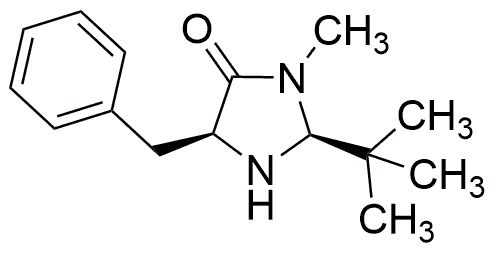(2S,5S)-(-)-2-tert-Butyl-3-methyl-5-benzyl-4-imidazolidinone is widely utilized in research focused on
- Pharmaceutical Development: This compound serves as a key intermediate in the synthesis of various pharmaceuticals, particularly in the development of drugs targeting neurological disorders due to its ability to modulate neurotransmitter systems.
- Catalysis: It is employed as a chiral ligand in asymmetric catalysis, enhancing the efficiency of chemical reactions and enabling the production of enantiomerically pure compounds, which are crucial in the pharmaceutical industry.
- Material Science: The compound is used in the formulation of advanced materials, including polymers and coatings, where its unique structural properties contribute to improved durability and performance.
- Biochemical Research: Researchers utilize this compound in studies related to enzyme inhibition and protein interactions, providing insights into metabolic pathways and potential therapeutic targets.
- Agrochemicals: It finds applications in the development of agrochemical products, enhancing crop protection formulations by improving the efficacy of active ingredients against pests and diseases.
General Information
Properties
Safety and Regulations
Applications
(2S,5S)-(-)-2-tert-Butyl-3-methyl-5-benzyl-4-imidazolidinone is widely utilized in research focused on
- Pharmaceutical Development: This compound serves as a key intermediate in the synthesis of various pharmaceuticals, particularly in the development of drugs targeting neurological disorders due to its ability to modulate neurotransmitter systems.
- Catalysis: It is employed as a chiral ligand in asymmetric catalysis, enhancing the efficiency of chemical reactions and enabling the production of enantiomerically pure compounds, which are crucial in the pharmaceutical industry.
- Material Science: The compound is used in the formulation of advanced materials, including polymers and coatings, where its unique structural properties contribute to improved durability and performance.
- Biochemical Research: Researchers utilize this compound in studies related to enzyme inhibition and protein interactions, providing insights into metabolic pathways and potential therapeutic targets.
- Agrochemicals: It finds applications in the development of agrochemical products, enhancing crop protection formulations by improving the efficacy of active ingredients against pests and diseases.
Documents
Safety Data Sheets (SDS)
The SDS provides comprehensive safety information on handling, storage, and disposal of the product.
Product Specification (PS)
The PS provides a comprehensive breakdown of the product’s properties, including chemical composition, physical state, purity, and storage requirements. It also details acceptable quality ranges and the product's intended applications.
Certificates of Analysis (COA)
Search for Certificates of Analysis (COA) by entering the products Lot Number. Lot and Batch Numbers can be found on a product’s label following the words ‘Lot’ or ‘Batch’.
*Catalog Number
*Lot Number
Certificates Of Origin (COO)
This COO confirms the country where the product was manufactured, and also details the materials and components used in it and whether it is derived from natural, synthetic, or other specific sources. This certificate may be required for customs, trade, and regulatory compliance.
*Catalog Number
*Lot Number
Safety Data Sheets (SDS)
The SDS provides comprehensive safety information on handling, storage, and disposal of the product.
DownloadProduct Specification (PS)
The PS provides a comprehensive breakdown of the product’s properties, including chemical composition, physical state, purity, and storage requirements. It also details acceptable quality ranges and the product's intended applications.
DownloadCertificates of Analysis (COA)
Search for Certificates of Analysis (COA) by entering the products Lot Number. Lot and Batch Numbers can be found on a product’s label following the words ‘Lot’ or ‘Batch’.
*Catalog Number
*Lot Number
Certificates Of Origin (COO)
This COO confirms the country where the product was manufactured, and also details the materials and components used in it and whether it is derived from natural, synthetic, or other specific sources. This certificate may be required for customs, trade, and regulatory compliance.


